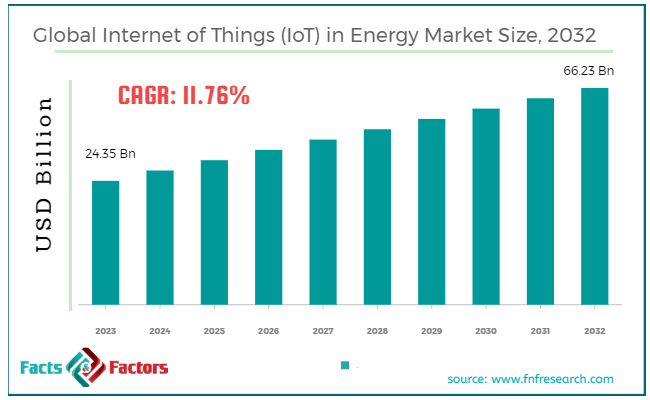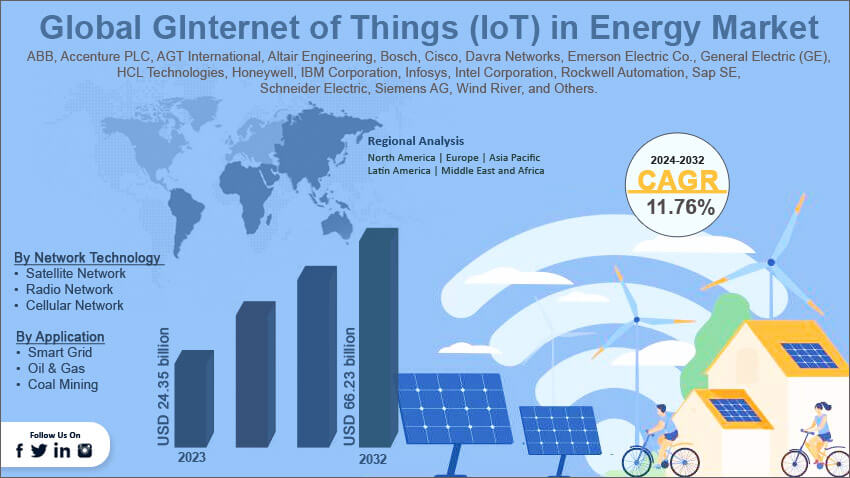Search Market Research Report
Internet of Things (IoT) in Energy Market Size, Share Global Analysis Report, 2024 – 2032

Internet of Things (IoT) in Energy Market Size, Share, Growth Analysis Report By Network Technology (Satellite Network, Radio Network, Cellular Network, and Others), By Component (Services, Platform, and Solutions), By Application (Smart Grid, Oil & Gas, and Coal Mining), and By Region - Global and Regional Industry Insights, Overview, Comprehensive Analysis, Trends, Statistical Research, Market Intelligence, Historical Data and Forecast 2024 – 2032
Industry Insights
[222+ Pages Report] According to Facts & Factors, the global internet of things (IoT) in energy market size in terms of revenue was valued at around USD 24.35 billion in 2023 and is expected to reach a value of USD 66.23 billion by 2032, growing at a CAGR of roughly 11.76% from 2024 to 2032. The global internet of things (IoT) in energy market is projected to grow at a significant growth rate due to several driving factors.

 Market Overview
Market Overview
The Internet of Things (IoT) in energy refers to the integration of connected devices and sensors into various energy systems, such as electricity grids, renewable energy installations, and energy consumption monitors. IoT devices collect and transmit data in real time, enabling energy providers and consumers to gain detailed insights into energy production, distribution, and usage. This connectivity allows for enhanced operational efficiency, predictive maintenance, and more dynamic management of energy resources.
IoT technologies in the energy sector can facilitate significant improvements in grid management through smart grids that adjust to changes in energy demand and supply automatically. For renewable energy sources like wind and solar, IoT can optimize production by adjusting to weather conditions and other environmental factors.
Additionally, IoT enables better demand response strategies by allowing energy systems to respond to real-time data on consumption patterns, thereby helping to balance load and reduce outages. Overall, Internet of Things (IoT) in energy promotes sustainability by improving energy efficiency, reducing waste, and contributing to a more reliable and adaptable energy infrastructure.
 Key Highlights
Key Highlights
- The internet of things (IoT) in energy market has registered a CAGR of 11.76% during the forecast period.
- In terms of revenue, the global internet of things (IoT) in energy market was estimated at roughly USD 24.35 billion in 2023 and is predicted to attain a value of USD 66.23 billion by 2032.
- The market for IoT in energy is rapidly expanding due to the increasing demand for smart and efficient energy solutions driven by global efforts to reduce carbon footprints and enhance energy sustainability.
- Based on the component, the services segment is growing at a high rate and is projected to dominate the global market.
- Based on the application, the smart grid segment is projected to swipe the largest market share.
- By region, Asia Pacific region will dominate the global internet of things (IoT) in energy market.

 Growth Drivers:
Growth Drivers:
- Rising Demand for Energy Efficiency: Growing concerns about climate change and energy costs are driving the need for efficient energy management. IoT solutions offer granular data and real-time insights, enabling consumers and businesses to optimize their energy consumption.
- Smart Grid Modernization: Aging infrastructure and the integration of renewable energy sources necessitate grid modernization. IoT plays a crucial role by providing the communication network and data analytics capabilities needed for a smarter, more responsive grid.
- Government Initiatives: Many governments are implementing policies and incentives to promote energy efficiency and renewable energy adoption. These initiatives often encourage the use of IoT-based solutions, further accelerating market growth.
- Advancements in Sensor Technology: The development of increasingly sophisticated and affordable sensors makes it easier and more cost-effective to collect real-time energy data from various sources, further fueling market expansion.
 Restraints:
Restraints:
- Cybersecurity Concerns: Connecting devices to a network creates potential vulnerabilities. Ensuring robust cybersecurity measures and data privacy protocols are essential for wider adoption.
- Interoperability Challenges: The lack of standardized communication protocols between different IoT devices can hinder seamless integration and data exchange within the IoE network.
- High Initial Investment Costs: Implementing IoT solutions, particularly for large-scale projects, can involve upfront costs for hardware, software, and system integration. This can be a barrier for some potential adopters.
- Consumer Awareness and Adoption: While interest in smart home technologies is growing, some consumers might not be fully aware of the benefits of IoT in energy management or might hesitate due to perceived complexity.
 Opportunities:
Opportunities:
- Focus on Data Analytics: Developing advanced data analytics tools and platforms will be crucial to extract valuable insights from the vast amount of energy data collected through IoT devices. This can lead to further optimization of energy consumption and grid management.
- Integration with Artificial Intelligence (AI): Combining IoT with AI can enable predictive maintenance for energy infrastructure, helping to prevent outages and improve overall grid reliability.
- Focus on User-Friendly Solutions: Developing user-friendly interfaces and mobile apps can enhance consumer awareness and encourage broader adoption of IoT-based energy management solutions.
- Subscription-Based Service Models: Subscription-based models can make IoT solutions more accessible by spreading the cost over time and offering a pay-as-you-go approach.
 Challenges:
Challenges:
- Standardization and Regulations: The lack of standardized regulations and data privacy laws across different regions can create uncertainty and hinder market growth. Establishing clear guidelines will be essential.
- Consumer Trust and Transparency: Building consumer trust regarding data privacy and security practices is crucial for widespread adoption. Transparency about data usage and robust security measures are key.
- Skilled Workforce Gap: The growing adoption of IoT in energy will require a skilled workforce with expertise in data analysis, cybersecurity, and system integration. Addressing this gap will be essential.
 Internet of Things (IoT) in Energy Market: Segmentation Analysis
Internet of Things (IoT) in Energy Market: Segmentation Analysis
The global internet of things (IoT) in energy market is segmented based on network technology, component, application, and region.
 By Network Technology Insights
By Network Technology Insights
Based on Network Technology, the global internet of things (IoT) in energy market is divided into satellite network, radio network, cellular network, and others. Satellite networks provide connectivity through satellites orbiting the earth, ideal for remote or rural areas where traditional network infrastructures are not feasible. Satellite networks are particularly beneficial for IoT applications in energy, such as monitoring remote pipelines or offshore wind farms, where other forms of connectivity might be unreliable or unavailable. The main advantage is their extensive coverage, although they often come with higher latency and costs.
Radio networks use radio frequencies for communication and are typically used for shorter-range applications but can be configured for longer ranges under certain setups. They are highly effective for applications like smart grids or in industrial settings where devices need to communicate over moderate distances. Radio networks can be more reliable and secure, offering a good balance between performance and cost.
Cellular networks, such as 4G and the emerging 5G networks, use cell towers to provide wide-area networking capabilities. The cellular network segment is expected to witness a high CAGR of about 13.17% during the forecast period. This technology is vital for IoT in urban and suburban energy systems, supporting high data rates and a large number of devices. The rollout of 5G is particularly significant, offering lower latency, higher speeds, and greater capacity, which are essential for real-time energy management and analytics.
 By Component Insights
By Component Insights
On the basis of Component, the global internet of things (IoT) in energy market is bifurcated into services, platform, and solutions. Services in the IoT energy market encompass installation, maintenance, integration, and consulting services that help manage and optimize IoT systems in energy applications. The services segment is expected to grow at a robust CAGR, estimated around 12.15%. This includes data analytics services, security services, and ongoing support to ensure systems operate efficiently and securely.
As IoT systems become more complex, the demand for professional services increases. These services are crucial for deploying and maintaining sophisticated IoT infrastructures that require specialized knowledge in both IT and energy systems.
Platforms in IoT energy systems serve as the backbone for device management, data collection, and integration. The platform segment is projected to experience a significant CAGR of around 18.22%. These platforms enable the interoperability of various IoT devices and manage the data flow between devices and to the user interfaces. They typically provide tools for monitoring, analytics, and decision-making support. The scalability and flexibility of IoT platforms are crucial as they allow energy companies to integrate new technologies and manage expanding networks of devices. This segment benefits from the increasing emphasis on data-driven decision making and operational efficiency.
Solutions in the IoT energy market include specific software and hardware offerings that provide targeted functionalities, such as smart meters, sensors, and energy management systems. This segment is expected to grow at a CAGR of approximately 15.20%. These solutions are designed to optimize specific processes within the energy sector, such as demand response, grid management, or asset tracking. The solutions segment is influenced by technological advancements that continually enhance the efficiency and capabilities of IoT devices. The integration of artificial intelligence and machine learning into IoT solutions is particularly impactful, enabling more sophisticated analysis and automation.
 By Application Insights
By Application Insights
Based on Application, the global internet of things (IoT) in energy market is categorized into smart grid, oil & gas, and coal mining. Smart grids utilize IoT devices to enhance the efficiency and reliability of electrical grids by enabling real-time monitoring and management of grid operations. The smart grid segment is projected to grow at a significant CAGR, estimated around 20.25%. IoT in smart grids involves the integration of smart meters, sensors, and automated devices that can communicate and respond to changing electricity demand and supply conditions. The demand for smart grid technologies is driven by the need to modernize aging electrical infrastructure, integrate renewable energy sources more effectively, and improve grid reliability and energy efficiency. IoT technologies help utilities manage peak load times, detect and respond to outages, and even anticipate maintenance needs.
In the oil and gas segment, IoT is used to improve operational efficiencies and safety through remote monitoring of pipelines and offshore platforms, predictive maintenance of equipment, and automation of hazardous operations. This sector’s focus on reducing operational costs and enhancing safety is driving the adoption of IoT solutions. IoT devices can provide critical data that helps prevent spills, leaks, and other safety risks, while also optimizing the performance and lifespan of equipment. The IoT in the oil and gas application is expected to witness a CAGR of about 15.18%.
IoT applications in coal mining involve monitoring and managing underground operations through sensors and devices that track air quality, personnel location, equipment condition, and more. These technologies are critical for improving mine safety, operational efficiency, and environmental monitoring. The coal mining sector is expected to grow at a moderate CAGR of around 10.12%. The main drivers for IoT in coal mining are the enhancement of safety measures and the increase in operational efficiency. IoT technologies enable real-time hazard detection and better resource management, which are crucial in the challenging and hazardous environment of coal mines.
 Recent Developments:
Recent Developments:
- ABB, a frontrunner in power and automation technologies, continues to champion innovation in the smart energy sector. Their open software platform, initially introduced in March 2020, remains a valuable tool for developers and industry partners.
- In January 2020, China Unicom Group and Huawei Technologies Co. Ltd unveiled a pioneering 5th generation indoor distributed Massive MIMO solution. This innovation marks a significant advancement in bringing 5th generation Massive MIMO technology indoors, enhancing the capabilities of 5th generation networks for indoor environments. This milestone is set to expand the horizons for Internet of Things (IoT) applications and other advanced technologies within indoor spaces.
 Report Scope
Report Scope
Report Attribute |
Details |
Market Size in 2023 |
USD 24.35 Billion |
Projected Market Size in 2032 |
USD 66.23 Billion |
CAGR Growth Rate |
11.76% CAGR |
Base Year |
2023 |
Forecast Years |
2024-2032 |
Key Market Players |
ABB, Accenture PLC, AGT International, Altair Engineering, Bosch, Cisco, Davra Networks, Emerson Electric Co., General Electric (GE), HCL Technologies, Honeywell, IBM Corporation, Infosys, Intel Corporation, Rockwell Automation, Sap SE, Schneider Electric, Siemens AG, Wind River, and Others. |
Key Segment |
By Network Technology, By Component, By Application, and By Region |
Major Regions Covered |
North America, Europe, Asia Pacific, Latin America, and the Middle East &, Africa |
Purchase Options |
Request customized purchase options to meet your research needs. Explore purchase options |
 Internet of Things (IoT) in Energy Market: Regional Analysis
Internet of Things (IoT) in Energy Market: Regional Analysis
- Asia-Pacific region is likely to grow at the fastest rate during the forecast period.
The Asia-Pacific region shows the fastest growth in the IoT in energy market, with the highest CAGR among all regions. This rapid expansion is driven by urbanization, industrialization, and the increasing need for sustainable energy solutions in populous countries like China and India. Both countries are heavily investing in smart infrastructure and IoT to address their massive energy demands and management challenges. The region's growth is also fueled by improvements in ICT infrastructure, which facilitates the broader adoption of IoT technologies.
North America is a leader in the IoT in energy market, primarily due to advanced technological infrastructure, high adoption of smart energy solutions, and stringent regulatory frameworks promoting energy efficiency and sustainability. The United States and Canada are at the forefront, with widespread deployment of smart grids, smart meters, and IoT-based monitoring systems to optimize energy usage and management. The region exhibits a robust CAGR, driven by continuous investments in IoT technology from both private and government sectors.
Europe closely follows North America in the IoT in energy market, supported by aggressive environmental policies and initiatives such as the European Green Deal, which aims to make energy systems smarter and more efficient using IoT technologies. Countries like Germany, the UK, and France lead in adopting IoT solutions for energy management, focusing on reducing carbon footprints and enhancing renewable energy integration. The market's CAGR in Europe is competitive, propelled by strong regulatory support and high consumer awareness.
In the Middle East and Africa, the IoT in energy market is developing, with countries such as the UAE and Saudi Arabia leading the way in adopting smart energy solutions. These countries are leveraging IoT to transform their energy sectors, particularly to increase efficiency and manage resources better in a region characterized by high energy consumption and production. The market’s growth in this region is expected to accelerate as more nations begin to recognize the benefits of IoT in managing and optimizing energy usage.
Latin America’s IoT in energy market is emerging, with gradual adoption driven by the need for energy efficiency and modernization of old infrastructure. Countries like Brazil and Mexico are beginning to invest in smart grid technology and IoT solutions to improve their energy systems' reliability and efficiency. While the region's CAGR is lower compared to Asia-Pacific or North America, it is expected to grow steadily as technology penetration increases and governments push for renewable energy and smart city projects.
 Internet of Things (IoT) in Energy Market: List of Key Players
Internet of Things (IoT) in Energy Market: List of Key Players
Some of the main competitors dominating the global internet of things (IoT) in energy market include;
- ABB
- Accenture PLC
- AGT International
- Altair Engineering
- Bosch
- Cisco
- Davra Networks
- Emerson Electric Co.
- General Electric (GE)
- HCL Technologies
- Honeywell
- IBM Corporation
- Infosys
- Intel Corporation
- Rockwell Automation
- Sap SE
- Schneider Electric
- Siemens AG
- Wind River
The global internet of things (IoT) in energy market is segmented as follows:
 By Network Technology Segment Analysis
By Network Technology Segment Analysis
- Satellite Network
- Radio Network
- Cellular Network
- Others
 By Component Segment Analysis
By Component Segment Analysis
- Services
- Platform
- Solutions
- Energy Management
- Power Distribution
- Mobile Workforce Management
- Asset and Equipment Monitoring
- Field Surveillance
- Network Management
- Others
 By Application Segment Analysis
By Application Segment Analysis
- Smart Grid
- Oil & Gas
- Coal Mining
 By Regional Segment Analysis
By Regional Segment Analysis
- North America
- The U.S.
- Canada
- Mexico
- Europe
- France
- The UK
- Spain
- Germany
- Italy
- Rest of Europe
- Asia Pacific
- China
- Japan
- India
- Australia
- Southeast Asia
- Rest of Asia Pacific
- The Middle East & Africa
- Saudi Arabia
- UAE
- Egypt
- Kuwait
- South Africa
- Rest of the Middle East & Africa
- Latin America
- Brazil
- Argentina
- Rest of Latin America
Industry Major Market Players
- ABB
- Accenture PLC
- AGT International
- Altair Engineering
- Bosch
- Cisco
- Davra Networks
- Emerson Electric Co.
- General Electric (GE)
- HCL Technologies
- Honeywell
- IBM Corporation
- Infosys
- Intel Corporation
- Rockwell Automation
- Sap SE
- Schneider Electric
- Siemens AG
- Wind River
Frequently Asked Questions

Copyright © 2024 - 2025, All Rights Reserved, Facts and Factors


